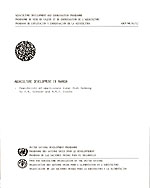
- Feasibility of small-scale rural fish farming
 | AQUACULTURE DEVELOPMENT IN RWANDA - Feasibility of small-scale rural fish farming |
by U.W. Schmidt and M.M.J. Vincke
Hyperlinks to non-FAO Internet sites do not imply any official endorsement of or responsibility for the opinions, ideas, data or products presented at these locations, or guarantee the validity of the information provided. The sole purpose of links to non-FAO sites is to indicate further information available on related topics.
This electronic document has been scanned using optical character recognition (OCR) software. FAO declines all responsibility for any discrepancies that may exist between the present document and its original printed version.
1.1 Context and purpose of report
1.2 The mission
1.3 Scope of report
1.4 Acknowledgements
2.1 Summary of findings
2.2 Recommendations
3.1 Geography and climate
3.2 Population
3.3 Land tenure and use
3.4 Food supplies
4.1 Supply, demand and price of fish
4.2 Potential for expansion
4.3 Present state of aquaculture
4.4 Research, development, training
5.1 Soil, climate and ecology
5.2 Systems of aquaculture
5.3 Choice of species
5.4 Fingerling production
5.5 Supplementary feeds
5.6 Fertilizing the ponds
5.7 Yields
6.1 The opportunity
6.2 Objectives
6.3 Outline and justification of proposed programme
6.4 Government action
6.5 International technical assistance
7. FARM-LEVEL FINANCIAL ANALYSIS
7.1 General considerations
7.2 Factor analysis
7.3 Estimates of costs and earnings
7.4 Comparison of marshland cultivation with and without fish farming
7.5 Comparative returns from fish and other crops
7.6 Cash flow analyses
8.1 Costs and benefits to the economy
8.2 Infrastructure
8.3 Constraints to development
8.4 Inputs
8.5 National impact of the development effort
9.1 Method of inquiry
9.2 Land and population
9.3 Socio-economic and socio-cultural aspects
9.4 Land use; leadership and decision-making
9.5 Motivation and mobility
9.6 Socio-economic impact of fish culture development
9.7 Summing-up
1 Agricultural regions of Rwanda
2 Potential demand for fish according to different consumption levels
and by prefecture
3 Peaty soils
4 Stocking rates in polyculture
5 Combined animal husbandry and fish culture
6 Fingerling production
7 Use of agricultural and industrial waste products for supplementary feeding
8 Feed formulae for fish in Rwanda
9 Fertilizers